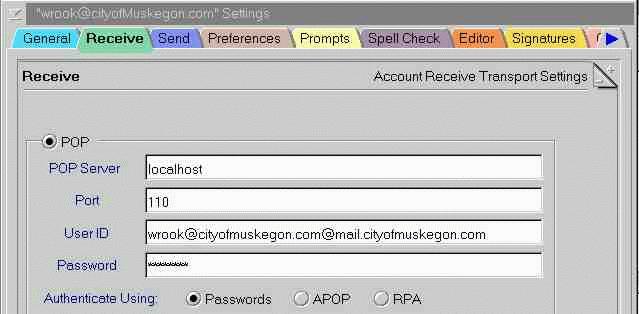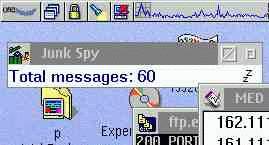 VOICE Home Page: http://www.os2voice.org |
[Previous Page] [Next Page] [Features Index] |
 VOICE Home Page: http://www.os2voice.org |
[Previous Page] [Next Page] [Features Index] |
By: Wilson Rook wrook@walkabout.org
As an ISP, I have many customers who are just plain sick of spam. I have been
reviewing a number of products to aid in the fight against spam. While there are
many potential solutions, I especially like my Junk Spy/PMMail combination. Some
solutions identify a potential piece of spam and refuse or delete the message. If
an e-mail is improperly identified, your mail is lost. Even Junk Spy has the option
to auto delete identified spam. In my configuration, however, due to requirements
of PMMail, this identify and destroy is not an option. Junk Spy works with PMMail's
filter capabilities to allow the redirection of mail to the trash folder or even
a special folder. This is really great because it gives you the chance to salvage
a misidentified message.
Junk Spy installed and worked very well with PMMail . There were no problems
with my main

After a few days of operation, I have almost forgotten about Junk Spy. Its operation
is very transparent and trouble free. Of course I did review my "Junk Spy"
folder in PMMail to find that Junk Spy identified a "Happy Valentines Day",
from a "Secret Admirer". To some this may look like an important message
- It is not. I did not check the message as it is my professional opinion that is
will be an advertisement for a site that I do NOT want to go to. Now dealing with
spam is as simple as a quick review of the Subjects and Senders followed by a "select
all" and "delete" from a presorted spam folder.
As my confidence of Junk Spy improves, I foresee the day where I send the filtered
mail directly to the trash. In the mean time, I know that I am receiving all of
my mail. I know no one else is censoring my mail. I have a quick easy way to deal
with spam. While this is not the only way for Junk Spy to function, it works very
well for me. Yes, this is my personal endorsement for this tool. An endorsement
for a tool that works.
Junk Spy is a product of Sundial Systems Corporations, http://www.sundialsystems.com/
.
TCP/IP 4.1 or not TCP/IP 4.1. As the brave yet sometimes foolish soul that I
am, I choose to continue installation with the 4.1 TCP/IP Stack. The Install program
reviewed my TCP/IP configuration and did not find any other problems. The Installation
completed successfully on the first try.
I elected to read through the "E-mail Getting Started Guides," which
were found open on my desktop hidden under some other open folders. A quick Ctrl-Esc
brought up the window list and I was moving on. The "E-mail Getting Started
Guides" consist of HTML documents that provide final configuration of your
particular e-mail client. Directions are provided for Post Road Mailer, MR/2 Ice,
Netscape 2.02, 4.04 & 4.61, jStreet, Polarbar, and my favorite PMMail . Generic
directions are also provided.
The guides provide a brief overview of the operation of Junk Spy. The changes
are simple; Attach your pop3 server name to your mail account name with an "@"
sign and change you Pop3 server to your localhost. If you don't quite understand
this, read the clearly written guide. The next step is a bit more involved for PMMail
requiring creation of a filter. Clear directions and graphics are provided. I wanted
to sort the junk mail into its own folder on my main e-mail account. If you wish
to do this, you will need to create the folder prior to creating the Filter.
I repeated the above steps for two additional e-mail accounts. These additional
accounts retrieved mail from an Inet.Mail Pro server running on OS/2. My second
e-mail account is configured on the server as a standard (non-virtual domain). Required
changes were the same as the above account. My third account was configured on an
Inet.Mail virtual e-mail domain. Virtual domains share a single IP address and are
dependent on your full e-mail address in your e-mail user ID field. Accordingly,
my existing "User ID" was listed as wrook@cityofmuskegon.com. I simply
followed the directions in the guide and changed the line to wrook@cityofmuskegon.com@mail.cityofmuskegon.com.

All was working quite well up to this point as I have spent more time typing
this review than installing Junk Spy. My first attempt of retrieving mail did not
work. Junk Spy did configure the option to autostart at startup. However, I did
not have to reboot after installation and Junk Spy, was not running. PMMail provided
an error message indicating that it could not find the localhost Pop server. Starting
the Junk Spy program brought up a window requesting the license number and Access
Code. Remember, there is a different password for the Web Site "Detection Update
Center" and that password will not work for registration.
The next window was a second warning about TCP/IP 4.1. [Refer to the above statement
about a foolish soul]. I choose to ignore the warning and try Junk Spy. After a
procedure that involved the power switch and chkdsk on startup, I went to the readme
file and did a "find" on "4.2". There I found a URL listed for
the TCP/IP 4.2, (a.k.a. Fixpak WR08620 a.k.a. MPTS Converged Fixpak v 5.3). [Note
this Fixpak is only for TCP/IP 4.1 - Nothing is needed if you have the GA TCP/IP
4.0]. Good clean documentation.
With the 4.2 stack loaded and a clean reboot, PMMail was opened and it checked
the mail automatically, I saw the Junk Spy program detect two messages. I expected
the messages because I went to the Sundial site while the Fixpak was being installed
and requested some Junk Mail. The first message from Sundial is a permission letter
to receive two junk mails for testing. The program worked like a charm. My own test
messages could be found in my inbox and the Junk mail was in my special Junk Spy
folder. Of course, I don't consider the test Junk Mail from Sundial to be a a true
test of filtering all Spam. However it did verify my PMMail setup and the proper
installation of Junk Spy. This is the small window of the program on my desktop
showing the number of messages processed.

At this point I knew the product was installed and functional. Further testing
resulted in very favorable results. This month I looked at the basic setup of Junkspy
out of the box. Next month I will take a further look into configuring Junkspy with
PMMail as well as setting it up to work with Netscape Messenger.
For more on Junk Spy see Sundial's site - http://www.sundialsystems.com/junkspy/index.html
Junk Spy can be ordered directly from Sundial Systems for $49, which includes
one year of detection database updates.
PMMail/2 also mentioned in this article is a product of Blueprint Software Works
Inc. - http://www.blueprintsoftware.com/